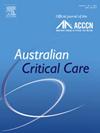Recruitment and retention of intensive care unit survivors in follow-up studies: A systematic review
IF 2.7
3区 医学
Q2 CRITICAL CARE MEDICINE
引用次数: 0
Abstract
Background
Engaging intensive care unit survivors in research is challenging. Studies have reported recruitment and attrition rates; details are lacking on retention strategies and attrition.
Objective
The aim of this study was to explore barriers and enablers to recruitment and retention in research of people post intensive care discharge.
Methods
A convergent mixed-method review using the Joanna Briggs Institute (JBI) methodology considered studies that reported on recruitment, retention, and attrition rates of adult post–intensive care survivors in longitudinal studies. CINAHL Ultimate (CINAHL+), PubMed, Excerpta Medica Database (EMBASE), PsycINFO, Scopus, Proquest Health, and Medical Collection were searched in March 2024 using Medical Subject Headings terms and keywords related to post–intensive care survivors, patient selection, and research in peer-reviewed journals or theses published in English. Risk of bias was assessed with JBI's critical appraisal tools. Qualitative data were extracted and themed, and quantitative data were extracted using predefined data fields and qualitised. Synthesis was guided by the JBI mixed-method convergent integrated approach.
Results
A total of 1608 records were identified; 12 high-quality articles were included, with a total of 2551 participants. Studies focussed on outcome measures following hospital discharge to the community. Three superordinate and eight subordinate themes emerged: factors influencing participation/nonengagement, retention strategies, and researcher insights. Attrition was predominantly due to mortality or ill health. Non-health-related themes included transport difficulties, expense, and inconvenience. Challenges included symptoms triggered by participation, being unaware of appointments, and not understanding study requirements. Enabling strategies included reminder calls, letters, cards, and home visits. Researcher insights included the impact of critical illness on survivors’ wellbeing, finances, and communication challenges.
Discussion
Recruitment and retention strategies were under-reported. Person-centred approaches considering survivors’ challenges may increase recruitment and retention. Retention strategies should be evaluated to determine the impact on engagement or withdrawal from studies. The strong likelihood of attrition should be factored into sample size calculations to reduce risk of bias in longitudinal studies.
Registration
This systematic review was registered in the International Prospective Register of Systematic Reviews (PROSPERO [CRD42022315688]).
随访研究中重症监护病房幸存者的招募和保留:一项系统回顾
让重症监护室幸存者参与研究是具有挑战性的。研究报告了招聘率和流失率;缺少关于留存策略和人员流失的细节。目的探讨重症监护出院人员招募和保留的障碍和促进因素。方法采用乔安娜布里格斯研究所(JBI)的方法,采用融合混合方法回顾了纵向研究中关于成人重症监护后幸存者的招募、保留和流失率的研究。我们于2024年3月检索了CINAHL Ultimate (CINAHL+)、PubMed、摘录医学数据库(EMBASE)、PsycINFO、Scopus、Proquest Health和Medical Collection,检索了与重症监护后幸存者、患者选择和同行评议期刊或英文论文研究相关的医学主题词和关键词。使用JBI的关键评估工具评估偏倚风险。定性数据提取和主题化,定量数据提取使用预定义的数据字段和限定。综合采用JBI混合收敛集成方法。结果共鉴定记录1608份;纳入12篇高质量文章,共2551名受试者。研究的重点是出院后到社区的结果测量。三个上级和八个下级主题出现了:影响参与/不参与的因素,保留策略和研究人员的见解。损耗主要是由于死亡或健康状况不佳。与健康无关的主题包括交通困难、费用和不便。挑战包括参与引发的症状,不知道预约,不了解研究要求。启用策略包括提醒电话、信件、卡片和家访。研究人员的见解包括重症对幸存者的健康、财务和沟通挑战的影响。招聘和留用策略未被充分报道。考虑到幸存者面临的挑战,以人为本的方法可能会增加招聘和保留。应评估保留策略,以确定对参与或退出学习的影响。为了减少纵向研究中的偏倚风险,在计算样本量时应考虑到极有可能发生的人员流失。该系统综述已在国际前瞻性系统综述注册(PROSPERO [CRD42022315688])中注册。
本文章由计算机程序翻译,如有差异,请以英文原文为准。
求助全文
约1分钟内获得全文
求助全文
来源期刊

Australian Critical Care
NURSING-NURSING
CiteScore
4.90
自引率
9.10%
发文量
148
审稿时长
>12 weeks
期刊介绍:
Australian Critical Care is the official journal of the Australian College of Critical Care Nurses (ACCCN). It is a bi-monthly peer-reviewed journal, providing clinically relevant research, reviews and articles of interest to the critical care community. Australian Critical Care publishes peer-reviewed scholarly papers that report research findings, research-based reviews, discussion papers and commentaries which are of interest to an international readership of critical care practitioners, educators, administrators and researchers. Interprofessional articles are welcomed.
 求助内容:
求助内容: 应助结果提醒方式:
应助结果提醒方式:


